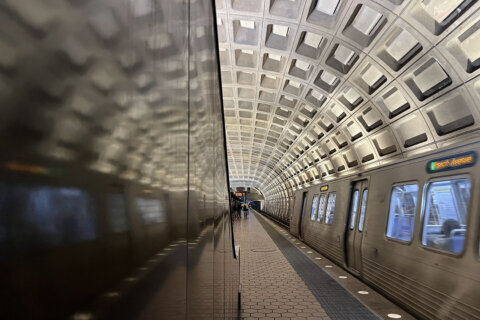WASHINGTON — With overall expenses going up and the number of rail riders going down, Metro is facing a trend that looks like an alligator opening its mouth to chomp down on wallets across the region.
Michael Goldman, Metro board’s finance committee chair, said the “alligator gap” between growing expenses and more slowly growing revenues could lead to service cuts next year in addition to fare increases and increased contributions from local governments.
“We’ve got to take a look at what’s the route structure, whether we need to make service cuts on the bus side, service cuts on the rail side, to be more in line with what our current ridership and revenue expectations and projections are,” Goldman said.
Metro expects the operating budget for the year beginning July 1, 2017 to require about $300 million in savings, additional contributions from jurisdictions, increased fares or other revenue.
“We’re not going to solve those problems the way we’ve tried to do it in the past just with either fare hikes or increases in subsidy. We need kind of a broader program,” Goldman said. “Yes, fare hikes I think are going to be part of it, an increase in subsidy from the jurisdictions are going to be part of it, but I think we have to be looking at some other components as well if we’re going to close this budget gap.”
Any effort to raise fares, cut service or increase contributions from jurisdictions could set off a new round of jurisdictional fighting on the Metro Board among representatives of Maryland, D.C., Virginia and the federal government.
An outside consultant from McKinsey & Company outlined what Goldman referred to as the “alligator gap” Thursday for the Metro board’s finance committee.
“Clearly the growth in labor costs relative to the growth in revenues is a fundamental long-term problem that has got to be addressed in some form,” consultant Tyler Duvall said.
On the cost side, labor is Metro’s largest driver, but Duvall said the way productivity is measured determines whether costs have grown too much.
“You can either measure it by the size of the system, in which case it would look OK — the physical size — or you can measure it by the demand on the system, in which case it looks like it’s actually declining,” he said.
The decline would be based on the dropping ridership, with far fewer riders using Metro today than any time in the last 10 years.
“This is quite a worrisome chart here,” Duvall said.
When the number of riders is compared with the fast-growing population in the region, the numbers look even dimmer: When adjusted for population changes, ridership in 2015 was only 86 percent of the 2005 levels.
Because fares have gone up several times in the last decade, most recently in 2014, fare revenue has not dropped, but it has not risen significantly either. Had ridership not dropped, Duvall estimates Metro could have brought in $44 million more in 2015.
“We are not in a position to say today there is a silver bullet cause for this decline in ridership,” he said.
Broader reasons for the decline that were suggested include the changing federal workforce, increases in telecommuting, declining gas prices, the increase in telework, gentrification in downtown areas and the “Uberfication” of transportation.
Metro also must face the dismal rider ratings: Internal measures show riders only give Metro a 56 percent reliability rating.
“It’s clear that there’s a relationship between declining customer satisfaction and rail ridership,” Duvall said. “This has got to get reversed.”
The drop-off is at all times of day, including significant declines outside of rush hours and on weekends, when Metro trains regularly share a single track or stations are shut down.
At peak periods, problems with railcars are the single largest cause of train offloads and delays.
“If our customers are giving us a grade of 56 percent on reliability … anyone in business, you are in deep trouble if you are at 56 percent,” said Malcolm Augustine, a Metro board member from Prince George’s County.
While Metro is working to improve car maintenance and hopes for eventual benefits from the ongoing accelerated track repairs, Goldman said savings are needed soon “as we look at this widening alligator gap between revenues and expenses.”
Metro and its largest union, Amalgamated Transit Union Local 689, were in contract negotiations after their most recent collective bargaining agreement expired at the end of June.
The two sides agreed not to discuss the details of negotiations with reporters.
In addition to the operating budget gap, Metro has failed for years to fully fund pension plans or other post-employment benefits like health care for retirees. Those unfunded obligations are projected to be well over $1 billion.






